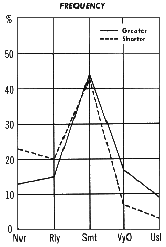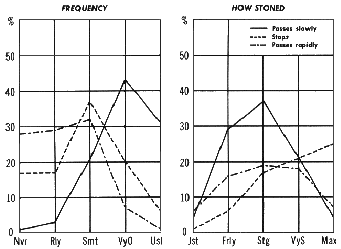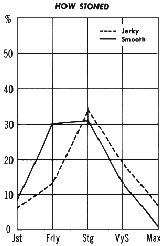Chapter 9. Space and Time
| Books - On Being Stoned |
Drug Abuse
Chapter 9. Space and Time
SPACE
EXPERIENCES, EVENTS, do not just happen; they happen to a person at a place at a time. This chapter will deal with many important changes in the perception of and orientation to the matrix of space and time during marijuana intoxication. Some 11 items specifically dealt with this in the questionnaire, and another 11 items from other sections are clearly relevant, as well as all the effects on Memory discussed in Chapter 14. The question of the person who experiences things in the space/time matrix will be dealt with in Chapter 18.
PERCEPTION OF SPACE
Distance
The third most characteristic effect of marijuana intoxication is "When I walk someplace, my experience of the distance covered is quite changed (e.g., not being aware of the space between, just seeming to suddenly be there or, conversely, feeling that it takes an immense number of steps to cover the distance" (1%, 3%, 18%, 45%, 33%). The minimal level of intoxication is generally Low to Moderate (7%, 27%, 41%, 19%, 3%). The Therapy and Growth group and the Meditators have to be less intoxicated for this (p <.01, overall) than the ordinary user.
 |
| Figure 9-1. DISTANCES |
Even when the user is not moving about himself, distances change: "Distances between me and things or me and other people seem to get greater; they are further away" (13%, 15%, 44%, 17%, 9%) is a common effect, which, occurs at Moderate to Strong levels of intoxication (3%, 17%, 27%, 19%, 8%). The converse effect, "Distances between me and other things or people seem to get shorter; they are closer" is also common (23%, 20%, 43%, 7%, 3%) as a mid-range effect (4%, 17%, 27%, 19%, 3%). As shown in Figure 9-1, distances' seeming greater occurs somewhat more frequently (p <.01), but levels of intoxication for these linked effects do not differ significantly.
The college-educated need to be somewhat more intoxicated than the Professionals for distances to seem shorter (p < .05).
Spatial Orientation
Spatial orientation may be completely lost temporarily: "I get so lost in fantasy or similar trips in my head that I completely forget where I am, and it takes a while to reorient after I come back and open my eyes" is common (15%, 22%, 37%, 19%, 8%) but occurs mainly at the very high levels of intoxication (1%, 3%, 20%, 33%, 24%). This is reported as occurring less often by the Daily users (p <.05, overall). Two related phenomena, dealt with fully in Chapter 11, are "I have lost all consciousness of my body during fantasy trips, i.e., gotten so absorbed in what was going on in my head that my body might as well have not existed for a while" and "I have lost all consciousness of my body and the external world and just found myself floating in limitless space (not necessarily physical space)." The experience of floating in limitless space is infrequent and is reported as occurring significantly less frequently than losing consciousness of the body per se during fantasy (p < .001) or losing consciousness of the body sufficiently to need to reorient (p <.05). None of the three phenomena differ significantly in levels of intoxication, all being very high-level phenomena. The latter two items are probably variants of the same phenomenon.
Quality of "Empty" Space
An infrequent but rather dramatic phenomenon is "The space or air around me takes on a solid quality; it is no longer 'empty' space" (41%, 21%, 26%, 7%, 2%), which occurs at relatively high levels of intoxication (0%, 3%, 15%, 19%, 13%) for those who could rate it. My informants indicate that this phenomenon may take a visual form, with the air or space taking on faint, vibrating colors, or a "tactual" form in that the air or space "feels" solid even though there is no visual change; space, rather than being a nonperceptible abstraction, becomes an immediate experience. The Weekly users report this most often (mode at Rarely/Sometimes), with both Occasional and Daily users having a modal occurrence rate of Never (p <.05, overall). The Meditators experience it more frequently than the Therapy and Growth group or the ordinary users (p <.05, overall). The Professionals need to be more intoxicated than do the College-educated to experience the air becoming solid (p <.05).
Related Phenomena
Related phenomena of space, dealt with in other chapters, are the visual effects of Chapter 6, such as pictures' acquiring a third dimension, the world's looking flat, visual centrality, and visual jiggle; and the auditory restructuring of space, greater separation between sound sources, and space becoming an auditory space, dealt with in Chapter 7.
SPACE PHENOMENA AND LEVELS OF INTOXICATION
Figure 9-4 presents the various perceived alterations of space by levels of intoxication. The overall differences in levels are highly significant (p <<<.0005). At the lowest levels of intoxication no changes in space are generally reported. At Moderate levels, distances frequently change, and sound sources seem further apart. As one goes higher, visual qualities of space may become less important as organizing factors, and perceived space may be unstable (jiggle); and at the very highest levels of intoxication, awareness of ordinary space may disappear completely, with the user lost in fantasy or floating in a purely mental space.
TIME
PERCEPTION OF TIME
Passage of Time
One of the most characteristic effects of marijuana intoxication is "Time passes very slowly; things go on for the longest time (e.g., one side of a record seems to play for hours)" (1%, 3%, 21%, 43%, 31%). The effect begins to occur at Moderate levels of intoxication (4%, 29%, 37%, 21%, 4%). The only background variable modulating this characteristic effect is total marijuana use; Heavy Total users must be more intoxicated to experience this (p <.05, overall).
An even more radical alteration of time is the common effect, "Time seems to stop; it's not just that things take longer, but certain experiences are outside of time, are timeless" (17%, 17%, 37%, 20%, 6%). Priestley (1964) has dealt with this phenomenon and calls it the experience of archetypal time. It generally does not begin to occur until very high levels of intoxication are reached (1%, 6%, 17%, 21%, 25%). It is reported as occurring more frequently by Females (p <.05). Non-users of Psychedelics experience it at higher levels of intoxication than Users (p <.05).
 |
| Figure 9-2. PERCEPTION OF TIME Note.—For guide to interpreting the "How Stoned" graph, see note on Figure 6-1. |
The converse of time's slowing or stopping is "Time passes very rapidly; things finish almost before they seem to have gotten started," an infrequent effect (28%, 29%, 32%, 7%, 1%) of the middle levels of intoxication (6%, 16%, 19%, 18%, 7%). Females experience this more frequently than Males (p < .05), and Heavy Total users more frequently than Light or Moderate Total users (p <.05, overall). The Therapy and Growth group must be more intoxicated to experience time as passing rapidly than the Meditators (p <.01) or the Ordinary Users (p <.01).
The interrelationships between time passing rapidly, slowly, or stopping are shown in Figure 9-2. Time passing slowly is more frequent than time stopping (p <<.001), and time stopping occurs more frequently than time passing rapidly (p <.001). While the distributions of minimal levels of intoxication do not differ significantly for time passing slowly or rapidly, the experience of time stopping occurs at higher levels of intoxication (p <<.001 for either comparison).
An aspect of time passing more slowly has already been presented in the phenomenon of a long delay between chewing something and tasting it (see chapter 8); this delay phenomenon occurs far less frequently (p <<<.001) than a general slowing of time, but at approximately the same level of intoxication.
Time stopping—archetypal time—was also investigated with respect to shift in identity in the item "Some events become archetypal, part of the basic way Man has always done things... ," which is dealt with fully in Chapter 18. It occurs about as frequently as time stopping, but at lower levels of intoxication (p <.01).
Events and the Passage of Time
Not only is it characteristic of marijuana intoxication for time to seem to pass more slowly; it is common for events to fit more smoothly into this slowed time: "Events and thoughts flow more smoothly; the succession of events in time is smoother than usual" (12%, 16%, 38%, 20%, 11%). This begins to occur at Moderate levels (8%, 30%, 31%, 13%, 1%). The Therapy and Growth group has to be more intoxicated to experience this increased smoothness of flow (p <.05, overall).
 |
| Figure 9-3. FLOW OF EVENTS IN TIME Note.—For guide to interpreting the "How Stoned" graph, see note on Figure 6-1. |
The converse common effect, "Events and thoughts follow each other jerkily; there are sudden changes from one thing to another" (13%, 23%, 35%, 19%,5%) occurs at significantly higher (p <.001) levels of intoxication (6%, 13%, 34%, 19%, 7%), as illustrated in Figure 9-3.
Meditators experience jerkiness in the flow of time less often than ordinary users (p <.05) or than the Therapy and Growth group (p <.05). Users of Psychedelics need to be more intoxicated to experience this jerkiness (p < .05).
Here-and-Now-ness
Two time phenomena may be alterations in the perception of time per se or possibly consequences of some of the changes described above. A characteristic effect is "I give little or no thought to the future; I'm completely in the here-and-now," and a related very common effect is "I do things with much less thought to possible consequences of my actions..."; both are dealt with fully in Chapter 15.
Déjà Vu
"While something is happening, I get the funny feeling that this sequence has happened before, in exactly the same way. Even though I logically know that it couldn't have happened before, it feels strange, as if it's repeating exactly (this is called a déjà vu experience and should not be confused with a false memory)" is a common experience (21%, 23%, 37%, 16%, 3%), which occurs at the middle level of intoxication (4%, 16%, 27%, 20%, 7%). While this is a phenomenon of memory by conservative standards, it would certainly influence a user's view of the nature of time. Some users, for example, interpret déjà vu as evidence for reincarnation. Similarly ostensible precognition (see page 100), while occurring rarely, could also strongly influence a user's view of the nature of time.
In terms of a human experience, and particularly a marijuana user's experience, the common physical view of time as an impersonal abstraction flowing along at a constant rate, with only the present being real, is inadequate, for some people may experience: (I) the past and future as being as real as the present at times; (2) the rate of time flow changing radically; (3) time stopping (archetypal time); and (4) events fitting smoothly or jerkily into the flow of time.
Note also that all memory effects (Chapter 14) are relevant to time effects, but they will not be discussed here.
LEVELS OF INTOXICATION FOR TIME PHENOMENA
Figure 9-4 presents various time phenomena ordered by levels of intoxication. The overall ordering is highly significant (p <<<.0005). As with space, there are no alterations of time commonly occurring at the very low levels of intoxication, but beginning between Fairly and Strongly, time is usually experienced as slowing. Going a little higher, the user is quite likely to feel much more in the here-and-now and may give less thought to the consequences of his actions. At higher levels actions take on an archetypal quality, and at the highest levels time may seem to stop, in that actions seem somehow removed from time, not a part of the inevitable flow.
| Just | Fairly | Strongly | Very Strongly |
Maximum | |||||
|
|
|||||||||
|
|||||||||
| FLOAT IN LIMITLESS SPACE | |||||||||
| TIME STOPS | |||||||||
| LOST IN FANTASY, NEED TO REORIENT | |||||||||
| Precognition | |||||||||
| AIR, SPACE BECOMES SOLID | |||||||||
| ACTIONS HAVE ARCHETYPAL QUALITY | |||||||||
| VISUAL JIGGLE | |||||||||
| DEJA VU | |||||||||
| DELAY BETWEEN CHEWING AND TASTING | |||||||||
| FLOW OF EVENTS IRREGULAR, JERKY | |||||||||
| TIME PASSES MORE RAPIDLY | |||||||||
| THINGS APPEAR DIFFERENT IN PERIPHERAL VISION | |||||||||
| MORE CENTRALITY TO VISION | |||||||||
| VISUAL WORLD LOOKS FLAT | |||||||||
| DISTANCES SEEM SHORTER | |||||||||
| SPACE BECOMES AN AUDITORY SPACE | |||||||||
| LESS THOUGHT TO CONSEQUENCES OF ACTIONS | |||||||||
| MORE IN THE HERE-AND-NOW | |||||||||
| DISTANCES SEEM GREATER | |||||||||
| TIME PASSES MORE SLOWLY | |||||||||
| PICTURES ACQUIRE AN ELEMENT OF DEPTH | |||||||||
| DISTANCE IN WALKING CHANGED | |||||||||
| EVENTS FLOW MORE SMOOTHLY | |||||||||
| GREATER SEPARATION BETWEEN SOUND SOURCES | |||||||||
|
|
|||||||||
| Just | Fairly | Strongly | Very Strongly |
Maximum | |||||
ADDITIONAL EFFECTS
"Time moves discontinuously" (Usually, Strongly).
"The world is more real" (Usually, Fairly).
LEVELS OF INTOXICATION FOR SPACE AND TIME PHENOMENA
Space and time form a tightly interwoven matrix in experience, so in some ways the division of space and time phenomena in the above discussions has been artificial. Figure 9-4 presents both space and time phenomena by level of intoxication, a significant overall ordering (p <<<.0005).
As the marijuana user becomes moderately intoxicated, the space/time matrix of experience seems to change; distances he moves around in change in size, time slows down, and sound begins to have some structuring effect on the space/time matrix. As he becomes strongly intoxicated, a variety of effects on his visual perception of the space of the world around him may occur, typically of the sort that involve him more in the space/time matrix (here-and-now-ness, centrality of vision, distances affected by his interest in objects). Moving into the high levels of intoxication, space may take on a structure or texture rather than being an abstract thing, and actions may take on an archetypal quality as the ordinary character of time becomes less binding on experience. He may sometimes become so lost in inner thoughts and fantasies that it takes some time to reorient to where he is. At the highest levels, time may seem to stop, actions to be out of the framework of physicalistic time, and he may also completely lose touch with the ordinary space/time continuum and experience floating in limitless space.
In general, the higher in level of intoxication one goes, the less binding the ordinary space/time matrix is on experience. One methodological difficulty created by this is that the descriptions of experiences at high levels can become less adequate, for language was evolved within the context of a quite rigid space/time matrix.
MODULATING FACTORS
A summary of the effects of various linearly-acting background variables is presented in Table 9-1. The effect of these background variables is quite complex.
Frequency of use has a curvilinear effect on the experience of air or space as taking on a "solid" quality; Weekly users have a modal report of Rarely/Sometimes, while the mode for both Daily and Occasional users is Never.
| BACKGROUND FACTORS | EFFECTS | |
|---|---|---|
| More Drug Experience | More frequent: Time flows rapidly Space becomes an auditory space Precognition Actions archetypal; More intoxicated for: Time flows slowly Jerkiness of events Visual centrality Space becomes an auditory space |
Less frequent: Delay between chewing and tasting Totally in here-and-now Lose track, need to reorient Lose consciousness of body during fantasy Less intoxicated for: Less thought to consequences of actions Time stops |
| Meditation | More frequent: Air, space solid |
Less frequent: Jerkiness of events Less intoxicated for: Totally in here-and-now Walking distance changed Space becomes an auditory space |
| Therapy & Growth | More intoxicated for: Events flow smoothly |
Less intoxicated for: Walking distance changed |
| More educated | More intoxicated for: Air, space solid |
Less intoxicated for: Space becomes an auditory space Distances seem shorter |
| Males | More intoxicated for: Actions archetypal |
Less frequent: Time stops Time flows rapidly |
| Older | Less intoxicated for: Float in limitless space |
|
SUMMARY
A major set of perceived effects of marijuana intoxication is the alteration of the space/time matrix in which all experience is set. This characteristically takes the form of increased attention to the present at the expense of the past and future (here-and-now-ness). Spatial dimensions may alter, and such alteration is affected by sound, music, and the user's attention. At the high levels of intoxication, experiences are increasingly less structured by the ordinary physical space/time matrix. At the highest levels, time may seem to stop, the user may experience archetypal time, where he is part of a pattern that man has always been part of, and he may temporarily lose consciousness of the ordinary space/time framework altogether, thus having experiences, which are inadequately communicated by language.
| < Prev | Next > |
|---|












